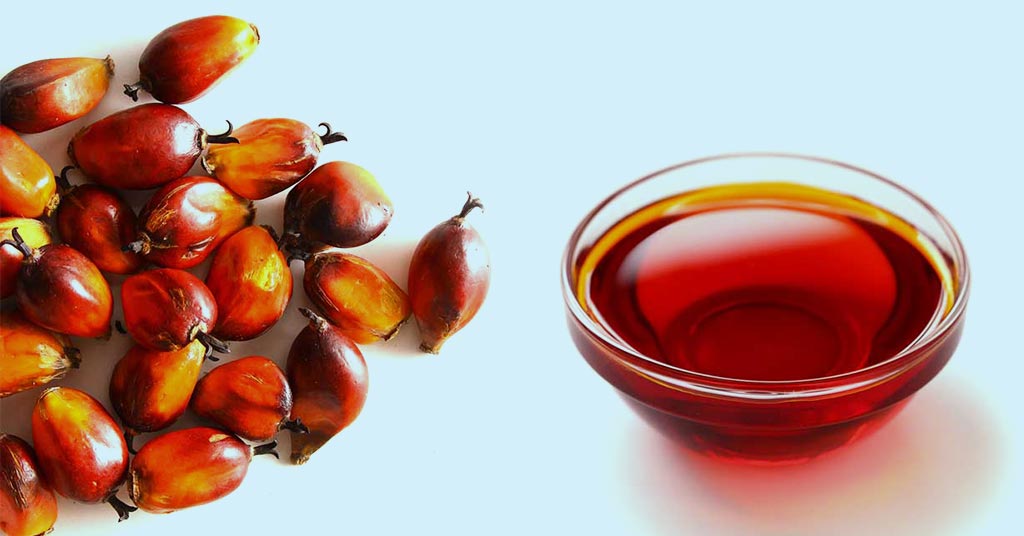Palm Oil Uses, Benefits & Side Effects
- 01-Mar-2023 6:52 PM
- Journalist: Nicholas Seifield
In the past years, the use of Palm Oil in the production of food products has recently been the subject of growing discussion. Due to its high adaptability as a trans-fat-free food component and low price, Palm Oil makes up one-third of all plant oil produced across the world. Elaeis guineesis, a Palm that is native to West and Southwest Africa, is the primary source of it. But, cultivation of this plant has recently become widely popular in Southeast Asia, particularly in Malaysia and Indonesia. The most popular vegetable oil in the world is Palm Oil. Regions around the equator are home to oil Palm trees.
The oil Palm plants produce bunches of fruit when they are three to four years old. All year long, the fruit bunches are collected, and there are numerous Palm fruits in each cluster. The size of a Palm fruit is comparable to an olive. The fruit only contains one seed or kernel, which is used to make Palm Kernel Oil or PKO. In each Palm fruit, around 30–35% of the oil is present. Every year, one Palm tree generates 40 kg of oil. The International Union for Conservation of Nature (IUCN) asserts that "Palm Oil is crucial for world food security and economic development."
Palm Oil – World's most widely used Vegetable Oil
Since it contributes to deforestation, the increased cultivation of Palm trees has given rise to several odds and ends of concerns. Although the effect of Palm Oil production on deforestation is outside the purview, it is important for one to know the fact that the oil yield per hectare of Palm crops is 3–8 times higher than that of alternative oil-producing crops, including sunflower, soybean, rapeseed, and corn. Crude Palm Oil (CPO), which comes from the fruit's fibrous mesocarp and is the highest natural source of tocotrienols, is bitter and has a crimson color from the presence of natural carotenoids. Degumming, bleaching, and deodorising are the three processes of refining CPO processing that result in Refined, Bleached, And Deodorised (RBD) Palm. The majority of producers in Europe refine CPO first, then fractionate it. Cooking, frying, shortenings, and margarines all use RBD Palm olein. The principal uses for RBD Palm stearin in food are shortenings and margarines, which call for a higher solid fat content.
There are two methods employed for producing Crude Palm Oil (CPO): wet extraction and dry extraction processes. The fruit is initially treated with steam and absorbs additional water in the wet method before the extraction process starts. In the dry method, dry heat is used to first roast the fruit before extraction techniques are used. Oil produced using these two processes is of varying quality. Organic solvents are typically used in the usual process of oil extraction. Supercritical Fluid Extraction (SFE) and the production of microemulsions in aqueous solutions containing surfactants have both been used in the extraction of oil recently to lessen the influence of organic solvents on the environment. Several techniques, such as mechanical, solvent extraction, micro-emulsion, and Supercritical Fluid Extraction (SFE), can be used to extract Palm Oil.
In most Asian countries during the past three decades, the Palm Oil industry has been quickly growing. Worldwide, Indonesia (59%), Malaysia (25%), Thailand (4%), and Nigeria (2%) are the top producers of Palm Oil. The two nations that export the most Palm Oil are Malaysia and Indonesia. Moreover, Palm Oil wastewater—free of fatty acids generated from Palm Oil—is used as a substitute energy source to create Biodiesel. Making Biodiesel from Palm Oil is really more sustainable than alternative methods and could aid in lowering greenhouse gas emissions. Furthermore, future demand for Palm Oil is expected to increase due to legal mandates that have been put in place for the use of biofuels in several nations. The Palm Oil business in Malaysia has elevated this nation to the position of the world's second-largest producer and exporter of Palm Oil.
Unfortunately, the widespread production of Palm Oil has led to certain environmental issues and the destruction of some of the most biodiverse forests on the planet. Environmental impact is thought to have resulted from industrial oil extraction by-products such as mesocarp leftover fibre, shell, and Palm Oil Mill Effluent (POME). Another significant environmental worry is the degradation of the rainforest for Palm tree plantations.
Palm oil Health Benefits-
Throughout the past few decades, a great deal of research has been done on the biological impacts of Palm Oil. It has been documented that Palm Oil has protective properties against chronic diseases, improves blood circulation, and regulates blood sugar.
About 1% of crude Palm Oil and red Palm Oil include substances known as Phytochemicals that could be beneficial for human health. Carotenoids (B carotene, approximately 15 times higher than in carrots) and Vitamin E are two of these phytochemicals. In actuality, Palm Oil contains the highest amount of Vitamin E than any other vegetable oil. According to reports, both tocopherol and carotenoids have antioxidant capabilities that shield cells and tissues from the harmful effects of free radicals.
There is no discernible increase in serum total cholesterol following the consumption of Palm Oil, according to several human studies conducted in the USA, Europe, and Asia. The tocotrienols in Palm Oil have additional advantages for health. Tocotrienols may lower the risk of stroke, according to recent research. It has been demonstrated that the tocotrienols in Malaysian Palm Oil target particular pathways to prevent the death of neural cells and lessen brain damage after stroke.
Food Applications:
Palm olein, stearin/super olein, and PMF have been used for different food applications. Cake shortenings made from Palm Oil products such as hydrogenated or interesterified Palm Oil, in combination with butterfat, produce cakes with better baking properties and are widely used by confectioners.
For situations where solid fat is preferred, Palm Oil can be used in place of butter or hydrogenated vegetable oils because of its high saturated nature, which makes it solid at room temperature in temperate climates. The growing usage of Palm Oil in the food sector may have been influenced by the health issues associated with trans fats found in hydrogenated vegetable oils.
In calf milk replacement, Palm Oil is occasionally used in small amounts.
Industrial Applications:
The main industrial products made from Palm Oil include soap, hand and body lotions, fatty acid methyl esters, and epoxidized Palm Oil.
In the oleo-chemical sector, Palm Oil and Palm Kernel Oil are used to create chemical feedstock, such as fatty acids and fatty esters, which are then utilized to manufacture a variety of non-food goods.
Palm Oil can also be used straight-up to make biofuel. With anaerobic digestion, renewable bio-energies like biomethane and biohydrogen are produced from the Palm Oil Mill Effluent (POME). By reducing the POME waste Chemical Oxygen Demand (COD) of wastewater, this procedure benefits the environment.
Kernel cake residues from PKO extraction can be used as a source of feed for animals. Remains from Palm fruit bunches are burned in the boilers to provide steam and energy for the processing facility. Furniture, building materials, pulp, and paper are all made from the trunks, fronds, and kernel shells of trees. For the creation of biocomposites, Palm Oil fibre that is derived from fruit bunches is being studied.
Due to the rising demand for this oil globally, the Palm Oil business is continually expanding. One of the most popular cooking oils, particularly in Asian nations and fast-food establishments, Palm Oil is used in a variety of applications. Lately, Palm Oil has been utilized in a number of industrial processes, which has increased the demand for Palm tree plantations across the globe.



